Abstract
Many big cities around the world are located near mountains. In city-mountain regions, thermally and topographically forced local winds are produced and they affect the transport of pollutants emitted into the urban atmosphere. A better understanding of the dynamics of thermally and topographically forced local winds is necessary to improve the prediction of local winds and to cope with environmental problems. In this study, we theoretically examine the interactions of urban breezes with mountain slope winds in the presence of basic-state wind within the context of the response of a stably stratified atmosphere to prescribed thermal and mechanical forcing. The interactions between urban breezes and mountain slope winds are viewed through the linear superposition of individual analytical solutions for urban thermal forcing, mountain thermal forcing, and mountain mechanical forcing. A setting is considered in which a city is located downwind of a mountain. In the nighttime, in the mountain-side urban area, surface/near-surface horizontal flows induced by mountain cooling and mountain mechanical forcing cooperatively interact with urban breezes, resulting in strengthened winds. In the daytime, in the urban area, surface/near-surface horizontal flows induced by mountain heating are opposed to urban breezes, giving rise to weakened winds. It is shown that the degree of interactions between urban breezes and mountain slope winds is sensitive to mountain height and basic-state wind speed. Particularly, a change in basic-state wind speed affects not only the strength of thermally and mechanically induced flows (internal gravity waves) but also their vertical wavelength and decaying rate. The examination of a case in a setting in which a city is located upwind of a mountain reveals that basic-state wind direction is an important factor that significantly affects the interactions of urban breezes with mountain slope winds.






Similar content being viewed by others
References
Baik JJ (1992) Response of a stably stratified atmosphere to low-level heating—an application to the heat island problem. J Appl Meteorol 31:291–303
Baik JJ, Chun HY (1997) A dynamical model for urban heat islands. Bound-Layer Meteorol 83:463–477
Chun HY, Baik JJ (1998) Momentum flux by thermally induced internal gravity waves and its approximation for large-scale models. J Atmos Sci 55:3299–3310
Fernando HJS (2010) Fluid dynamics of urban atmospheres in complex terrain. Annu Rev Fluid Mech 42:365–389
Freitas ED, Rozoff CM, Cotton WR, Silva Dias PL (2007) Interactions of an urban heat island and sea-breeze circulations during winter over the metropolitan area of Sao Paulo, Brazil. Bound-Layer Meteorol 122:43–65
Ganbat G, Seo JM, Han JY, Baik JJ (2015) A theoretical study of the interactions of urban breeze circulation with mountain slope winds. Theor Appl Climatol 121:545–555
Lin YL (1987) Two-dimensional response of a stably stratified shear flow to diabatic heating. J Atmos Sci 44:1375–1393
Lin YL (2007) Mesoscale dynamics. Cambridge University Press, Cambridge
Markowski P, Richardson Y (2010) Mesoscale meteorology in midlatitudes. Wiley-Blackwell, Chichester
Queney P (1948) The problem of airflow over mountains: a summary of theoretical studies. Bull Am Meteorol Soc 29:16–26
Ryu YH, Baik JJ (2013) Daytime local circulations and their interactions in the Seoul metropolitan area. J Appl Meteorol Climatol 52:784–801
Simpson JE (1994) Sea breeze and local wind. Cambridge University Press, Cambridge
Smith RB (1980) Linear theory of stratified hydrostatic flow past an isolated mountain. Tellus 32:348–364
Smith RB, Lin YL (1982) The addition of heat to a stratified airstream with application to the dynamics of orographic rain. Q J R Meteorol Soc 108:353–378
Song IS, Chun HY (2005) Momentum flux spectrum of convectively forced internal gravity waves and its application to gravity wave drag parameterization. Part I: Theory J Atmos Sci 62:107–124
Yoshikado H (1992) Numerical study of the daytime urban effect and its interaction with the sea breeze. J Appl Meteorol 31:1146–1164
Acknowledgments
The authors are grateful to two anonymous reviewers for providing valuable comments on this work. The first, second, and fourth authors were supported by the National Research Foundation of Korea (NRF) grant funded by the Korea Ministry of Science, ICT and Future Planning (MSIP) (No. 2011-0017014) and also by the Korea Meteorological Administration Research and Development Program under grant KMIPA 2015-5100. The third author was supported by the R&D project on the development of Korea’s global numerical weather prediction systems of Korea Institute of Atmospheric Prediction Systems (KIAPS) funded by the Korea Meteorological Administration (KMA).
Author information
Authors and Affiliations
Corresponding author
Rights and permissions
About this article
Cite this article
Seo, J.M., Ganbat, G., Han, JY. et al. Theoretical calculations of interactions between urban breezes and mountain slope winds in the presence of basic-state wind. Theor Appl Climatol 127, 865–874 (2017). https://doi.org/10.1007/s00704-015-1674-9
Received:
Accepted:
Published:
Issue Date:
DOI: https://doi.org/10.1007/s00704-015-1674-9




